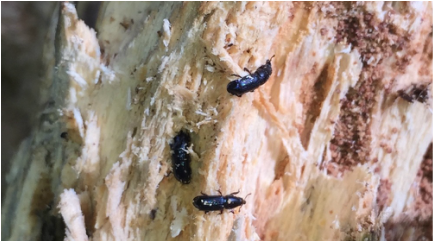There are two Main types of borer found in New Zealand:
Common House Borer - Anobium Punctatum
Two Toothed Longhorn Borer - Ambeodontus Trustus
Borer is a common pest in older homes (pre 1980's) where the timber used in floor boards, joists, frames, beams, and trusses etc were unlikely to have been treated against such potential destruction.
Borer damage, if left untreated can really affect the structural integrity of timber, so it is really important to get it treated, before the problem gets worse.
Common House Borer - Anobium Punctatum
Two Toothed Longhorn Borer - Ambeodontus Trustus
Borer is a common pest in older homes (pre 1980's) where the timber used in floor boards, joists, frames, beams, and trusses etc were unlikely to have been treated against such potential destruction.
Borer damage, if left untreated can really affect the structural integrity of timber, so it is really important to get it treated, before the problem gets worse.
 Common House Borer
Common House Borer
- Common house borer - Anobium Punctatum
 Two-Toothed Longhorn Borer
Two-Toothed Longhorn Borer
- Two-toothed longhorn borer - Ambeodontus Trustus This is New Zealands major native timber pest with their preferred diet being resinous heartwoods like Rumu, Matai, Kauri, Kaihikatea and Macrocarpa but they also enjoy sapwoods like untreated pirus radiata. The life cycle is similar to the common house borer, but the female lays up to 10 clusters of 15 - 20 eggs and the larvae live in the timber for 5-7 years. The insects exit holes are always oval and range from 3mm to 6mm long. The length of this beetle varies from 12mm to 25mm long.
Treatment
There are a few methods of treatment that PestAway use, however, we mostly use two methods that cover 90% of the realistic problems.
WE GIVE A GUARANTEE OF 10 YEARS ON OUR DIRECT SPRAYING BORER TREATMENTS
There are a few methods of treatment that PestAway use, however, we mostly use two methods that cover 90% of the realistic problems.
- Direct Spraying Method - The best, most effective treatment is to directly spray raw (untreated/unvarnished) timber with a permethrin insecticide mixed with an absorbing agent such as Linea Alkane. The chemical absorbs into the timber and not only kills the active borer, but the eggs as well. This is the most important thing to note about borer treatments. 'Borer Bombs' are good in that they will kill the active flying borer in ones home, but it will not absorb into the timber which is where the problem really lies. Once the timber has been treated, there is no evidence to say that the chemical will stay active for more than 30 years, however, PestAway offer a 10 year guarantee on this method.
- Pressure Injecting Method - On timber that has been painted on, or varnished (such as furniture, cladding, door frames etc), the above method is not effective as the chemical will not absorb through paint or varnish. The only way to get the borer control fluid into this timber is through pressure injecting each existing borer exit hole. Once inside the hole, the coverage will actually spread out deeper than the tunnels themselves, widening the coverage. While this method can work very well, we are limited to the holes that we can actually see, and cannot guarantee that we get every single hole, as there may be thousands.
WE GIVE A GUARANTEE OF 10 YEARS ON OUR DIRECT SPRAYING BORER TREATMENTS
